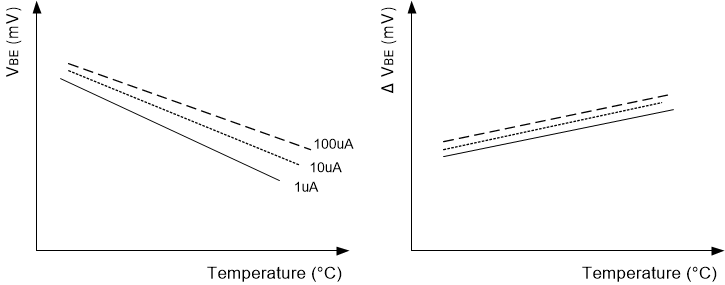DLPS081 February 2022 DLP3020-Q1
PRODUCTION DATA
- 1 Features
- 2 Applications
- 3 Description
- 4 Revision History
- 5 Pin Configuration and Functions
-
6 Specifications
- 6.1 Absolute Maximum Ratings
- 6.2 Storage Conditions
- 6.3 ESD Ratings
- 6.4 Recommended Operating Conditions
- 6.5 Thermal Information
- 6.6 Electrical Characteristics
- 6.7 Timing Requirements
- 6.8 Switching Characteristics
- 6.9 System Mounting Interface Loads
- 6.10 Physical Characteristics of the Micromirror Array
- 6.11 Micromirror Array Optical Characteristics
- 6.12 Window Characteristics
- 6.13 Chipset Component Usage Specification
- 7 Detailed Description
- 8 Application and Implementation
- 9 Power Supply Recommendations
- 10Layout
- 11Device and Documentation Support
- 12Mechanical, Packaging, and Orderable Information
Package Options
Mechanical Data (Package|Pins)
- FQR|54
Thermal pad, mechanical data (Package|Pins)
Orderable Information
7.3.6.1 Temperature Sense Diode Theory
A temperature sensing diode is based on the fundamental current and temperature characteristics of a transistor. The diode is formed by connecting the transistor base to the collector. Two different known currents flow through the diode and the resulting diode voltage is measured in each case. The difference in the base-emitter voltages is proportional to the absolute temperature of the transistor.
Refer to the TMP411-Q1 data sheet for detailed information about temperature diode theory and measurement. Figure 7-2 and Figure 7-3 illustrate the relationship between the current and voltage through the diode.
 Figure 7-2 Temperature Measurement Theory
Figure 7-2 Temperature Measurement Theory Figure 7-3 Example of Delta VBE vs Temperature
Figure 7-3 Example of Delta VBE vs Temperature